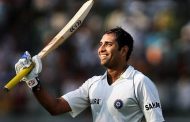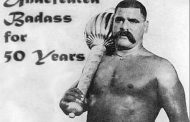The “Great” Gama also known as “Gama Pahalwan” born Ghulam Muhammad, in 22 May 1878 Amritsar, Punjab, British India, was a Kashmiri Muslim wrestler. He was awarded the Indian version of the World Heavyweight Championship on 15 October 1910. Undefeated in a career spanning more than 50 years, he has been billed as the greatest pahalwan of his time. After Independence in 1947, Gama moved to the newly created state of Pakistan.
Ghulam Muhammad, whose nickname was gama, was born in the family of a renowned wrestler, Muhammad Aziz of Punjab. He was from a Kashmiri family of Bhat clan. Maharaja Bhawani Singh, the ruler of the princely state of Datia, Madhya Pradesh patronized the young wrestler and his brother Imam Bakhsh. Gama was first noticed at the age of ten when he entered a strongman competition held in Jodhpur, which included many grueling exercises such as squats. The contest was attended by more than four hundred wrestlers and young Gama was among the last fifteen. At that point the Maharaja of Jodhpur announced Gama as the victor due to his remarkable show of enormous stamina and dedication among the many older wrestlers.
Gama’s daily training consisted of grappling with forty of his fellow wrestlers in the court. He used to do five thousand Baithaks (squats) and three thousand Dands (pushups).Gama’s daily diet was ten liters of milk, a pound and a half of crushed almond paste made into a tonic drink along with fruit juice and other ingredients to promote good digestion. This high protein and high energy diet helped him accumulate muscle mass.
Fame came to Gama at the age of 17 when he challenged the then Indian Wrestling Champion, middle aged Raheem Bakhsh Sultani Wala, a Muslim wrestler from Gujranwala, now in Punjab, Pakistan. At about 7 feet tall, with a very impressive win-loss record; Raheem was expected to easily defeat the 5’7″ Gama. Raheem’s only drawback was his age as he was much older than Gama, and near the end of his career. The bout continued for hours and eventually ended in a draw. The contest with Raheem was the turning point in Gama’s career. After that, he was looked upon as the next contender for the Indian Wrestling Championship. In the first bout Gama remained defensive, but in the second bout, Gama went on the offensive. Despite severe bleeding from his nose and ears, he managed to deal out a great deal of damage to Raheem Bakhsh.By 1910, Gama had defeated all the prominent Indian wrestlers who faced him except the champion, Raheem Bakhsh Sultani Wala. At this time, he focused his attention on the rest of the world. Accompanied by his younger brother Imam Bakhsh, Gama sailed to England to compete with the Western Wrestlers but could not gain instant entry, because of his lower height.
In London, Gama issued a challenge that he could throw any three wrestlers in thirty minutes of any weight class. This announcement however was seen as a bluff by the wrestlers and their wrestling promoter R. B. Benjamin.For a long time no one came forward to accept the challenge. In order to break the ice, Gama presented another challenge to specific heavy weight wrestlers. He challenged Stanislaus Zbyszko and Frank Gotch, either he would beat them or pay them the prize money and go home. The first professional wrestler to take his challenge was the American Benjamin Roller. In the bout, Gama pinned Roller in 1 minute 40 seconds the first time, and in 9 minutes 10 seconds the other. Second day, he defeated 12 wrestlers and thus gained entry to official tournament.
He was pitted against world champion Stanislaus Zbyszko and the date of bout was set as 10 September 1910. The match was contested over prize money and the John Bull Belt. Within a minute, Zbyszko was taken down and remained in that position for the remaining 2 hours and 35 minutes of the match. There were a few brief moments when Zbyszko would get up, but he just ended back down in his previous position. Crafting a defensive strategy of hugging the mat in order to nullify Gama’s greatest strengths, Zbyszko wrestled the Indian legend to a draw after nearly three hours of grappling, though Zbyszko’s lack of tenacity angered many of the fans in attendance. The two men were set to face each other again on 17 September 1910. On that date, Zbyszko failed to show up and Gama was announced the winner by default. He was awarded with the prize money and much famed John Bull Belt.Receiving this belt entitled Gama to be called Rustam-e-Zamana or World Champion.During this tour Gama defeated some of the most respected grapplers in the world, “Doc” Benjamin Roller of the United States, Maurice Deriaz of France, Johann Lemm (the European Champion) of Switzerland, and Jesse Peterson (World Champion) from Sweden. In the match against Roller, Gama threw “Doc” 13 times in the 15 minute match. Gama now issued a challenge to the rest of those who laid claim to the World Champion’s Title, including Japanese Judo champion Taro Miyake, George Hackenschmidt of Russia and Frank Gotch of the United States – each declined his invitation to enter the ring to face him. At one point, in order to face some type of competition, Gama offered to fight twenty English wrestlers, one after another. He announced that he would defeat all of them or pay out prize money, but still no one would take up his challenge.
Shortly after his return from England, Gama faced Raheem Bakhsh Sultani Wala in Allahabad. This bout eventually ended the long struggle between the two pillars of Indian wrestling of that time in favour of Gama and he won the title of Rustam-e-Hind or Champion of India. Later in his life when asked about who was his strongest opponent, Gama replied, “Raheem Bakhsh Sultani Wala”.After beating Raheem Bakhsh Sultani Wala, Gama faced Pandit Biddu, who was one of the best wrestlers in India of that time (1916), and beat him. In 1922, during a visit to India, the Prince of Wales presented Gama with a silver mace, which was symbolic of the one that is carried by the Hindu deity Hanuman, who represents strength and valour. Gama did not have any opponents until 1927, when it was announced that Gama and Zbyszko would face each other again. The day finally came in 1928 when both wrestlers met again in Patiala. The result of the bout was quick when Gama threw Zbyszko in only 42 seconds. At forty-eight years old he was now known as theThe Great Gama died in Lahore, Pakistan on 23 May 1960, after a long period of illness and general neglect.The portion of land given by Punjab Government (Pakistan) was used to treat his heart and asthma, and Gama was to face difficult days. G. D. Birla, an industrialist and wrestling fan, donated ₹2,000 and a monthly pension of ₹300, and after this generous help, the Government of Pakistan increased the pension to Gama and supported his medical expenses.Today, a doughnut-shaped exercise disc weighing 95 kg, used by him for squats, is housed at the National Institute of Sports Museum at Patiala.(WKKP)Agency.






